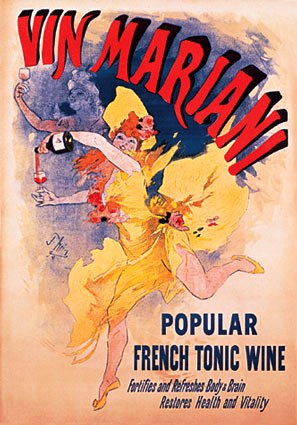Coca wine
Coca wine is a historical beverage that combines wine with an extract from the coca leaves. It was most popular in the late 19th and early 20th centuries, particularly in the United States and Europe. Coca wine is one of the earliest forms of cocaine consumption, as the coca leaf extract contains natural alkaloids, including cocaine. This article explores the history, production, and impact of coca wine.
History[edit | edit source]
The history of coca wine dates back to the 1860s when Angelo Mariani, a Corsican chemist, created "Vin Mariani," a coca leaf-infused wine. Mariani's concoction gained immense popularity for its supposed medicinal and health-enhancing properties. It was advertised as a tonic capable of relieving a variety of ailments, from fatigue to digestive issues, and even as a treatment for morphine addiction. Prominent figures of the time, including Thomas Edison, Queen Victoria, and Pope Leo XIII, were known to have consumed Vin Mariani.
Production[edit | edit source]
The production of coca wine involves steeping coca leaves in wine, allowing the alcohol to extract the active alkaloids from the leaves. The concentration of cocaine in coca wine varied, but Vin Mariani was reported to contain around 6 to 7.2 milligrams of cocaine per ounce of wine. The process mirrored that of making herbal wines, where the primary goal was to infuse the base liquid (wine, in this case) with the properties of the added substance (coca leaves).
Impact[edit | edit source]
Coca wine played a significant role in the early history of stimulants and psychoactive drugs in Western society. Its widespread popularity helped pave the way for the acceptance and use of cocaine in medical treatments and as a recreational drug. However, as the addictive properties and negative health effects of cocaine became more apparent, the popularity of coca wine waned. The passage of the Pure Food and Drug Act in 1906 in the United States, which required labeling of products containing cocaine and other narcotics, and the eventual prohibition of cocaine made coca wine virtually obsolete by the 1920s.
Legal and Social Issues[edit | edit source]
The rise and fall of coca wine highlight significant legal and social issues related to drug use and regulation. Initially marketed as a health tonic, the eventual recognition of its addictive properties and potential for abuse led to increased regulation and prohibition. This pattern has been seen with other substances and reflects broader societal and legal challenges in balancing the medicinal benefits of certain drugs with their potential for harm.
Legacy[edit | edit source]
Today, coca wine is remembered more for its historical significance than as a beverage of choice. It represents an era when the line between medicine and recreational drugs was often blurred, and it played a role in the early development of pharmaceutical regulations. The story of coca wine also provides insight into the cultural and social history of drug use, reflecting changing attitudes towards health, medicine, and drug consumption over time.
| Coca wine Resources | ||
|---|---|---|
|
| |
Navigation: Wellness - Encyclopedia - Health topics - Disease Index - Drugs - World Directory - Gray's Anatomy - Keto diet - Recipes
Search WikiMD
Ad.Tired of being Overweight? Try W8MD's physician weight loss program.
Semaglutide (Ozempic / Wegovy and Tirzepatide (Mounjaro / Zepbound) available.
Advertise on WikiMD
WikiMD is not a substitute for professional medical advice. See full disclaimer.
Credits:Most images are courtesy of Wikimedia commons, and templates Wikipedia, licensed under CC BY SA or similar.Contributors: Prab R. Tumpati, MD


